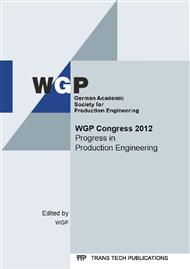[1]
Heracleous, L; Wirtz, J.: Doppelstrategie. Zwei Wege, ein Ziel. In: Harvard Business manager, (2010)11, 66–76.
Google Scholar
[2]
Petry, T.: Netzwerkstrategie. Kern eines integrierten Managements von Unternehmungsnetzwerken. 1. Ed. Wiesbaden: Dt. Univ. -Verl, (2006).
Google Scholar
[3]
Preißner, M.: Mittelstand leidet unter Bauchentscheidungen. Köln: Institut für Handelsforschung an der Universität zu Köln, (2008).
Google Scholar
[4]
Harris, E.: CEO Survey. Mergers & Acquisitions - the 1997 Business Week Symposium of CEOs, 1997. http: /www. bain. com/bainweb/publications/publications_detail. asp?id=14&menu_url=publications_results. asp, last visit 14. 02. (2010).
Google Scholar
[5]
Contractor, F. J; Lorange, P.: Why Should Firms Cooperate? The Strategy and Economics Basis for Cooperative Ventures. In: Contractor, F. J. and Lorange P. (Ed. ): Cooperative Strategies in International Business. Joint Ventures und Technology Partnerships between Firms. Lexington: D. C. Health and Company, 1988, 3–30.
DOI: 10.2307/258182
Google Scholar
[6]
Child, J; Faulkner, D; Tallman, S. B.: Cooperative strategy. 2. Ed. Oxford ;, New York: Oxford University Press, (2005).
Google Scholar
[7]
Yoshino, M. Y; Rangan, U. S.: Strategic alliances. An entrepreneurial approach to globalization. Boston, Mass: Harvard Business School Press, (1995).
Google Scholar
[8]
Bresser, R. K. F.: Kollektive Unternehmensstrategien. In: Zeitschrift für Betriebswirtschaft. 59(1989)5, 545–564.
Google Scholar
[9]
Dussauge, P; Garrette, B.: Cooperative Strategy. Competing successfully through strategic alliances. This ed. extensively rev. and updated. Chichester [u. a. ]: Wiley, (1999).
Google Scholar
[10]
Wegehaupt, P.: Führung von Produktionsnetzwerken. Aachen: Dissertation, Fakultät für Maschinenwesen, Rheinisch-Westfälische Technische Hochschule Aachen, (2004).
DOI: 10.15420/ecr.2007.0.1.51
Google Scholar
[11]
Christensen, C; Andrews, K; Bower, J; Hamermesh, G; Porter, M.: Business Policy. Text and Cases. Homewood, IL: Irwin, (1982).
Google Scholar
[12]
Mintzberg, H.: Strategy Formation. Schools of Thought. In: Fredrickson, J. W. (Ed. ): Perspectives on Strategic Management. New York: Harper Business, 1990, 105–236.
Google Scholar
[13]
Ansoff, H. I.: Strategic Management. London: Macmillan, (1979).
Google Scholar
[14]
Porter, M. E.: What Is Strategy? In: Harvard Business Review. 74(1996)6, 61–78.
Google Scholar
[15]
Scholz, C.: Strategische Organisation. Multiperspektivität und Virtualität. Landsberg/Lech: moderne industrie, (2000).
Google Scholar
[16]
Fricker, I. C.: Strategische Stringenz im Werkzeug- und Formenbau. Aachen: Shaker, (2005).
Google Scholar
[17]
Knyphausen-Aufsess, D. zu: Theorie der strategischen Unternehmensführung. State of the art und neue Perspektiven. Wiesbaden: Gabler, (1995).
Google Scholar
[18]
Venkatraman, N.: The Concept of Fit in Strategy Research. Toward Verbal and Statistical Correspondence. In: Academy of Management Review. 14(1989)3, 423–444.
DOI: 10.5465/amr.1989.4279078
Google Scholar


